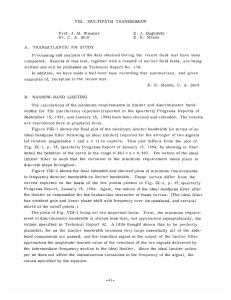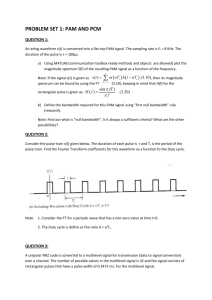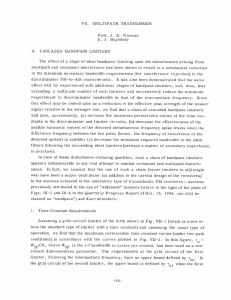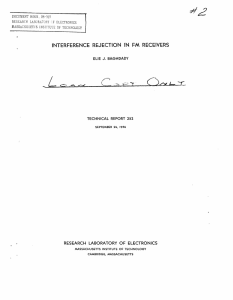IX. MULTIPATH TRANSMISSION E. E. Manna
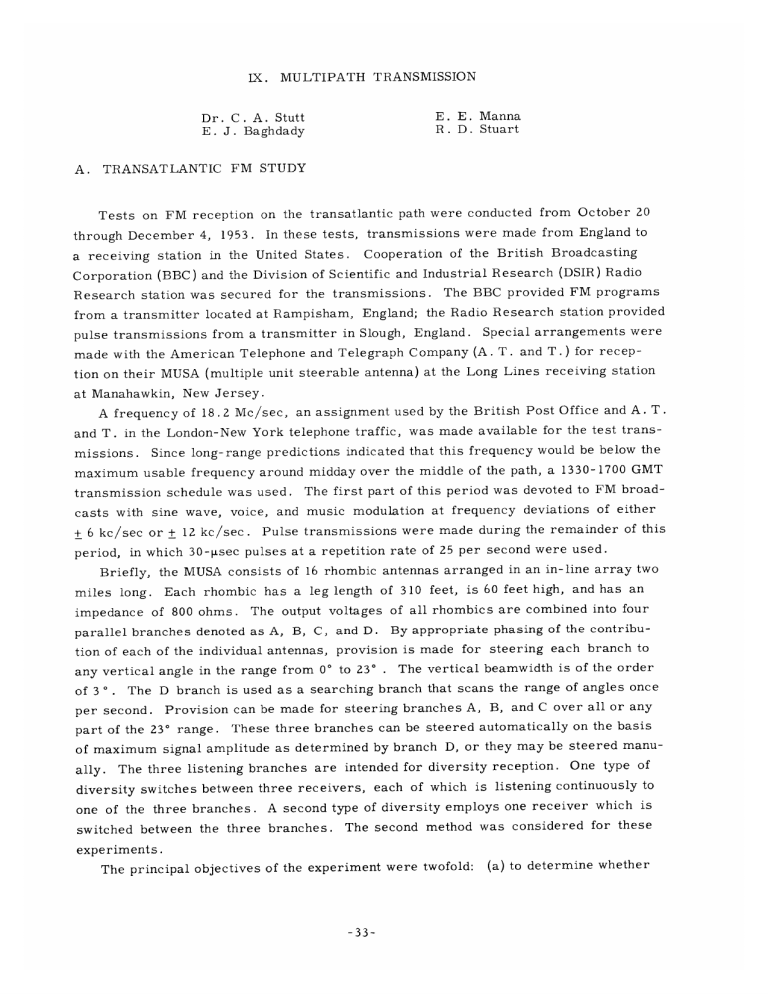
IX. MULTIPATH TRANSMISSION
Dr. C. A. Stutt
E. J. Baghdady
A. TRANSATLANTIC FM STUDY
E. E. Manna
R. D. Stuart
Tests on FM reception on the transatlantic path were conducted from October 20 through December 4, 1953. In these tests, transmissions were made from England to a receiving station in the United States. Cooperation of the British Broadcasting
Corporation (BBC) and the Division of Scientific and Industrial Research (DSIR) Radio
Research station was secured for the transmissions.
The BBC provided FM programs from a transmitter located at Rampisham, England; the Radio Research station provided pulse transmissions from a transmitter in Slough, England.
Special arrangements were made with the American Telephone and Telegraph Company (A. T. and T.) for reception on their MUSA (multiple unit steerable antenna) at the Long Lines receiving station at Manahawkin, New Jersey.
A frequency of 18.2 Mc/sec, an assignment used by the British Post Office and A. T.
and T. in the London-New York telephone traffic, was made available for the test transmissions. Since long-range predictions indicated that this frequency would be below the maximum usable frequency around midday over the middle of the path, a 1330-1700 GMT transmission schedule was used. The first part of this period was devoted to FM broadcasts with sine wave, voice, and music modulation at frequency deviations of either
+ 6 kc/sec or + 12 kc/sec. Pulse transmissions were made during the remainder of this period, in which 30-4sec pulses at a repetition rate of 25 per second were used.
Briefly, the MUSA consists of 16 rhombic antennas arranged in an in-line array two miles long. Each rhombic has a leg length of 310 feet, is 60 feet high, and has an impedance of 800 ohms. The output voltages of all rhombics are combined into four parallel branches denoted as A, B, C, and D.
By appropriate phasing of the contribution of each of the individual antennas, provision is made for steering each branch to any vertical angle in the range from 00 to 230 .
The vertical beamwidth is of the order of 3 .
The D branch is used as a searching branch that scans the range of angles once per second. Provision can be made for steering branches A, B, and C over all or any part of the 230 range. These three branches can be steered automatically on the basis of maximum signal amplitude as determined by branch D, or they may be steered manually. The three listening branches are intended for diversity reception. One type of diversity switches between three receivers, each of which is listening continuously to one of the three branches. A second type of diversity employs one receiver which is switched between the three branches.
The second method was considered for these experiments.
The principal objectives of the experiment were twofold:
(a) to determine whether
-33-
(IX. MULTIPATH TRANSMISSION)
angle of arrival discrimination would sufficiently foreshorten (or more correctly,
weight) the pulse pattern to make frequency modulation usable bn multipath with or without the aid of audio repair (see the Quarterly Progress Report, April 15, 1952, for discussion of effect of pulse pattern length or "smear time" on FM reception);
(b) to determine whether or not diversity reception on the three branches can improve
FM reception. Two questions should be answered in connection with the second objective: Are fades coherent for different arrival angles? Can switching be done fast enough to avoid trouble?
The data obtained in the experiments include a log of reception containing signalstrength records, magnetic tape recordings of the FM programs, and pictures and sketches of pertinent waveforms (sine waves and pulse patterns). In addition to tapes illustrative of FM reception on the MUSA, simultaneous recordings were made from identical FM receivers on the MUSA and on a single rhombic antenna (this antenna was identical with each element of the MUSA and was oriented in the same direction), and of FM reception on 18.2 Mc/sec and AM reception from a BBC station on 17.87 Mc/sec beamed at South Africa. Most of the data concerning the pulse transmissions are contained in film records. The following items were studied: the effect of the MUSA steering on the shape of the pulse pattern, comparison of pulse patterns obtained via the MUSA and via the single rhombic, variation of the pulse pattern with the arrival angle, and variation of the pulse pattern with time.
The data are now being processed and analyzed. Conclusions drawn from them will be reported at a later time.
C. A. Stutt, E. E. Manna
B. NARROW-BAND LIMITING
The results of the theoretical investigation mentioned in the Quarterly Progress
Report of October 15, 1953, are presented here in graphical form.
Figure IX-1 shows a plot of the limiter bandwidth required for two-carrier interference suppression. This was calculated by reasoning that the limiter bandwidth should be wide enough tQ accommodate the maximum swing in the instantaneous frequency of the resultant of the two signals of magnitude 1 and a, a <1, and frequencies p and p+ r, respectively. (See E. J. Baghdady: FM Interference Rejection with Narrow-Band
Limiters, Master's Thesis, Department of Electrical Engineering, M.I.T., 1953; and
J. Granlund: Interference in FM Reception, Technical Report No. 42, Research
Laboratory of Electronics, M. I. T., Jan. 1953.) Consequently, the discriminator characteristic should also be linear over the same range of frequency, and should hence be given by the same curve in Fig. IX-1. It turns out, however, that this reasoning is unnecessary (see thesis quoted above), and that, in fact, the minimum limiter bandwidth requirements are those displayed by the broken curve in Fig. IX-1, with
-34-
AS CALCULATED FROM
BW= I+a
I-a
MINIMUM
REQUIRED
F
E
0.2
1 I
0.4
I I 11111
0.6 0.8 1.0 a
Fig. IX-1
// a= 0.95
14
0
12 w cx a
LLI
I0 a=0.9
- a = 0.85
a = 0.8
0
--
I I
1 2
I I
3 4
I
5
(BW)LIM
(BW)I-F
I
6
I
7
I
8 9 10
Fig. IX-2
Z
6 z moU
5
\\ a
=
0.8
o
I
I I I I I I I
I 2 3 4 5 6 7
NUMBER OF LIMITER-FILTER STAGES
8
Fig. IX-3
(IX. MULTIPATH TRANSMISSION) correspondingly different requirements in the discriminator bandwidth.
Figure IX-2 shows how the requirement in the discriminator bandwidth varies with the limiter bandwidth used. The broken-line character of the curves results from the fact that the calculations were made in terms of an ideal limiter bandpass filter with vertical skirts and linear phase shift over the passband. Such a filter will either pass, or completely reject, any spectral components falling in the vicinity of its cutoff points.
As clearly shown in the above-mentioned thesis, the maximum instantaneous deviation in the frequency of the resultant signal at the output of the filter changes considerably as the number of components passed from either or both sidebands is changed. Since the discriminator characteristic must be linear over a band that is wide enough to accommodate the maximum swing in the frequency of the resultant signal at its input (for complete interference rejection), the requirement in discriminator bandwidth is affected sharply by the number of spectral components passed by the limiter filter. Clearly, for every value of limiter bandwidth used, the requirement in discriminator bandwidth is dictated by that configuration of spectral components passed that will give rise to the greatest instantaneous frequency deviations in the resultant signal. (Throughout this discussion the term "frequency deviation" is used to signify deviation from the desired frequency, p, pertaining to the stronger of the two signals.)
Figure IX-3 shows how, by cascading a sufficient number of stages of alternate limiting and filtering, it is possible to reduce the required discriminator bandwidth to that of intermediate frequency. The curve is plotted for a value of a
=
0.8, and is representative of cases where a < 0.8. The calculation becomes rather involved for values of a of the order of 0.85 and higher, since for such cases the discriminator bandwidth is dictated by cases where more than two spectral components are passed by the limiter filter. (See the thesis quoted above.)
The above-mentioned findings are being tested experimentally. A laboratory model receiver, previously used in transatlantic FM tests, is being used for the purpose. The outstanding features of the receiver (described in detail in Technical Report No. 42) are a 200 kc/sec i-f bandwidth flat to within 1 percent over 150 kc/sec, and a 6 Mc/secwide rapid-acting limiter-detector section. In particular, the receiver has 4 prelimiter stages, followed by 4 stages of good limiting. This makes it possible to insert filters between the limiter stages and study the effect of the filter bandwidth upon the interference rejection ability of the receiver.
Preliminary measurements have been carried out with a filter flat to less than
0.75 percent over 200 kc/sec, with a bandwidth of 480 kc/sec (measured to the halfpower points) and over-all amplification of 1.6. A capture ratio of a little over a= 0.89
was measured with 20-db suppression of interference, and of approximately a = 0.86
with 25-db suppression. As verified visually on the oscilloscope, the 20-db suppression criterion corresponds to the shift in average frequency from p to p + r, and accordingly
-36-
(IX. MULTIPATH TRANSMISSION) should be the one used in determining a.
More extensive measurements are underway at present. The results will be reported in the future, together with detailed descriptions of the technique and circuitry.
E. J. Baghdady
-37-
